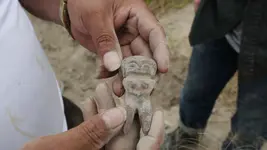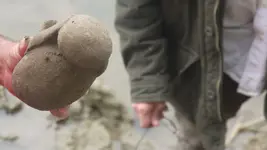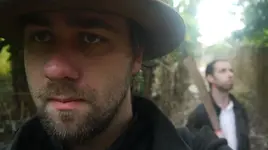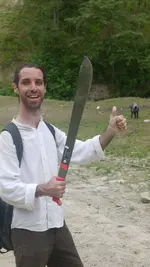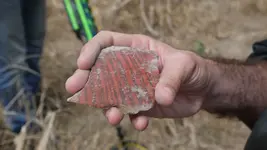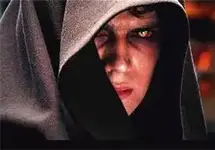Relic2010
Greenie
- #1
Thread Owner
Hi Guys!!!
I used to be an archaeologist, and have since become obsessed with applying that experience to treasure hunting. To that end, I developed a methodology (which has since become a book which I hope will be available later this year) which will enable anyone to find ancient treasure sites, and which is applicable to most cultures, civilizations and eras around the world.
To test it out, I travelled to South America, specifically to Ecuador, Peru and Bolivia, to see if I could use it to locate ancient sites. The results speak for themselves. Accompanied by an up and coming videographer, Jonathan David Holmes, I went in search of a lost city in the coastal jungles of Ecuador. Not only did we find the city, but we also located multiple other sites in the vicinity and elsewhere in the country.
The Lost City of the Jama
The city was one of those which had been sacked by none other than Francisco Pizzarro early on in his career, but which had been going on before the arrival of the Spaniards for hundreds of years, resulting in a ceremonial area and necropolis embracing as many as half a million graves. Many of those graves contained grave goods such as valuable antiquities, emeralds, gold and silver. Unfortunately, problems with gun men in the area (we were tracked by some of them and subsequently had to hide in the jungle, mere meters from them, watching them pass by whilst they searched for us) forced us to leave early.
The Lost Idol of the Jama Tomb
One of the great discoveries caught on film was what I call Jama Tomb 1. The tomb, located by a river, yielded a few dessicated human bones, large pieces of beautifully crafted pottery, complete with artistic designs, and a magnificent ceramic Precolumbian idol, typical of the Jama people, representing a fertility goddess.
Secrets of the Valdivians
Other discoveries made in other areas of the coast were from a farmer’s field which had once been an ancient Valdivian culture village. The Valdivian culture, famous for their gold nose rings and ceramic ‘venus’ figurines (which sell for up to five hundred dollars for a complete figurine, and only 100 – 300 for a broken one). The dig yielded various ceramic figurines such as Valdivian venuses, which were ceremonial items that were believed used for fertility rituals, and were almost always female. The figurines were ritually broken at either the neck or waist, and then ceremonially buried in the village plaza, which was the heart of the Valdivian religious life. They are believed to be some of the earliest ceramics of the New World, and date back approximately 5,000 years.
Legendary Tunnel Systems of the Incas
We also explored ancient tunnels in the area of Sacsayhuaman, Peru, long associated with rumors of treasure legends. The tunnels are further away from the short ‘tunnels’ shown to tourists. These were difficult to find, overgrown with grass, and dangerous to enter and navigate. Many of them began life as natural caverns but show signs of being extended by human hand. One was so hidden by grass that I actually fell down it up to my waist! Luckily, my foot found a small ledge and I was spared grevious injury. Often, I’d have to crawl on all fours to navigate a tunnel, fearing that it would collapse in on me at any minute. At other points, I could easily stand up and walk around.
Uncovering the Traces of Past Treasure Hunters
At one site in Ecuador, not far from Cuenca, I also happened to uncover yet another tomb and removed a well preserved femur from it. This particular bone probably belonged to one of the myriads of tombs discovered in the 1860’s which had created a gold craze in the small village, leading to the entire Precolumbian burial ground being despoiled in search of the yellow metal.
We did a lot in those months. We travelled down river in search of remnants of the ancient Montenita civilization, spoke to old huaceros (treasure hunters) about ruins, lost cities, ancient South American writing (which we went in search of) and even emeralds in the area, and searched the Ocucaje Desert for dinosaur fossils along with the curator of the world famous Ica Stones, Dr. Ernesto Cabrerra.
It’s been a year since the South American expedition ended, and the documentary of what I did there, named ‘What is Hidden, May Be Found’ is slated to be released in October/November of this year. Jonathan David Holmes, who accompanied me every step of the way up until we parted in Cuzco (John had to return early back to his native U.K. whilst I went on) has already won an accolade award for his efforts, and hopefully will continue to draw interest to his work.
I can teach anyone to do what I did. Sure, I went to college, but I’m a regular guy. Anyone can learn to locate these sites. To that end, I’m making my methodology for that available to the public, hopefully later on this year. The foundation, as you may have guessed, is solid research, as any treasure hunter worth their salt will tell you.
As I am unsure about TreasureNet’s policy regarding posting links, I’ll just post the link to the FB page. If that’s not allowed, the moderator can just remove it. You can simply google the documentary name ‘What is Hidden, May be Found’ as well. It has a facebook page that has photos and stills of the documentary, including photos of some of the artifacts such as the idols, etc. There are also trailers and some footage from South America. It is not yet available for purchase, however. I apologize if I’ve breached any forum regulation, or posted in the wrong area. If so, I didn’t mean it, and please feel free to delete what you must.
Anyone interested in discussing this or anything related to treasure hunting methodology can contact me directly (PM me), on this forum or leave comments on John’s FB page. A great methodology can produce great results. It would be great to put our heads together.
https://www.facebook.com/#!/WhatIsHiddenMayBeFound?fref=ts
Regards,
Relic
Note for moderator: this is the only treasure site I’ve posted on, and the FB page isn’t a treasure site. It’s about a documentary.
I used to be an archaeologist, and have since become obsessed with applying that experience to treasure hunting. To that end, I developed a methodology (which has since become a book which I hope will be available later this year) which will enable anyone to find ancient treasure sites, and which is applicable to most cultures, civilizations and eras around the world.
To test it out, I travelled to South America, specifically to Ecuador, Peru and Bolivia, to see if I could use it to locate ancient sites. The results speak for themselves. Accompanied by an up and coming videographer, Jonathan David Holmes, I went in search of a lost city in the coastal jungles of Ecuador. Not only did we find the city, but we also located multiple other sites in the vicinity and elsewhere in the country.
The Lost City of the Jama
The city was one of those which had been sacked by none other than Francisco Pizzarro early on in his career, but which had been going on before the arrival of the Spaniards for hundreds of years, resulting in a ceremonial area and necropolis embracing as many as half a million graves. Many of those graves contained grave goods such as valuable antiquities, emeralds, gold and silver. Unfortunately, problems with gun men in the area (we were tracked by some of them and subsequently had to hide in the jungle, mere meters from them, watching them pass by whilst they searched for us) forced us to leave early.
The Lost Idol of the Jama Tomb
One of the great discoveries caught on film was what I call Jama Tomb 1. The tomb, located by a river, yielded a few dessicated human bones, large pieces of beautifully crafted pottery, complete with artistic designs, and a magnificent ceramic Precolumbian idol, typical of the Jama people, representing a fertility goddess.
Secrets of the Valdivians
Other discoveries made in other areas of the coast were from a farmer’s field which had once been an ancient Valdivian culture village. The Valdivian culture, famous for their gold nose rings and ceramic ‘venus’ figurines (which sell for up to five hundred dollars for a complete figurine, and only 100 – 300 for a broken one). The dig yielded various ceramic figurines such as Valdivian venuses, which were ceremonial items that were believed used for fertility rituals, and were almost always female. The figurines were ritually broken at either the neck or waist, and then ceremonially buried in the village plaza, which was the heart of the Valdivian religious life. They are believed to be some of the earliest ceramics of the New World, and date back approximately 5,000 years.
Legendary Tunnel Systems of the Incas
We also explored ancient tunnels in the area of Sacsayhuaman, Peru, long associated with rumors of treasure legends. The tunnels are further away from the short ‘tunnels’ shown to tourists. These were difficult to find, overgrown with grass, and dangerous to enter and navigate. Many of them began life as natural caverns but show signs of being extended by human hand. One was so hidden by grass that I actually fell down it up to my waist! Luckily, my foot found a small ledge and I was spared grevious injury. Often, I’d have to crawl on all fours to navigate a tunnel, fearing that it would collapse in on me at any minute. At other points, I could easily stand up and walk around.
Uncovering the Traces of Past Treasure Hunters
At one site in Ecuador, not far from Cuenca, I also happened to uncover yet another tomb and removed a well preserved femur from it. This particular bone probably belonged to one of the myriads of tombs discovered in the 1860’s which had created a gold craze in the small village, leading to the entire Precolumbian burial ground being despoiled in search of the yellow metal.
We did a lot in those months. We travelled down river in search of remnants of the ancient Montenita civilization, spoke to old huaceros (treasure hunters) about ruins, lost cities, ancient South American writing (which we went in search of) and even emeralds in the area, and searched the Ocucaje Desert for dinosaur fossils along with the curator of the world famous Ica Stones, Dr. Ernesto Cabrerra.
It’s been a year since the South American expedition ended, and the documentary of what I did there, named ‘What is Hidden, May Be Found’ is slated to be released in October/November of this year. Jonathan David Holmes, who accompanied me every step of the way up until we parted in Cuzco (John had to return early back to his native U.K. whilst I went on) has already won an accolade award for his efforts, and hopefully will continue to draw interest to his work.
I can teach anyone to do what I did. Sure, I went to college, but I’m a regular guy. Anyone can learn to locate these sites. To that end, I’m making my methodology for that available to the public, hopefully later on this year. The foundation, as you may have guessed, is solid research, as any treasure hunter worth their salt will tell you.
As I am unsure about TreasureNet’s policy regarding posting links, I’ll just post the link to the FB page. If that’s not allowed, the moderator can just remove it. You can simply google the documentary name ‘What is Hidden, May be Found’ as well. It has a facebook page that has photos and stills of the documentary, including photos of some of the artifacts such as the idols, etc. There are also trailers and some footage from South America. It is not yet available for purchase, however. I apologize if I’ve breached any forum regulation, or posted in the wrong area. If so, I didn’t mean it, and please feel free to delete what you must.
Anyone interested in discussing this or anything related to treasure hunting methodology can contact me directly (PM me), on this forum or leave comments on John’s FB page. A great methodology can produce great results. It would be great to put our heads together.
https://www.facebook.com/#!/WhatIsHiddenMayBeFound?fref=ts
Regards,
Relic
Note for moderator: this is the only treasure site I’ve posted on, and the FB page isn’t a treasure site. It’s about a documentary.



